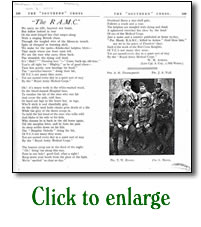The RAMC in War
The Royal Army Medical Corps was formed on the 23rd June 1898. The formation was the merger of the former Medical Staff with the Medical Staff Corps thus uniting the Senior Officers with the lower ranks. There was an element of the new Corps at the Boxer Rebellion in China, but the first warfare experience was in the South African War of 1899-1902 where the embryo of modern warfare took place, and the first results of high velocity rifle fire were found. The experiences of that war set up the organisation that took the field in France in 1914, but by 1918 it was a vastly different service indeed.
At the outbreak of the Great War, just 16 years after its formation, there were 9,000 Warrant Officers and Men of the RAMC; this grew to 113,000 by 1918. The British Army had never before fielded a field ambulance in conflict, the last of the great armies to have understood the importance of medical discipline, and hold medical science in high esteem, within their fighting forces were the old civilisations, such as the ancient empires of Greece and Rome.
Even today there is a general misconception that the function of the Medical Services in war is to just bind up wounds, but for centuries all knowledge had become lost. This resulted in medical affairs going way down on the list of priorities in the face of the enemy, and throughout this time Doctors and Physicians ranked below washerwomen. The management of care and welfare for the sick and the wounded was, therefore, inadequate, and many men were left neglected or were treated by untrained and unskilled individuals. Several were left in the hands of the enemy, and it has even been recorded that many, who appeared helpless or unlikely to make a recovery, were killed by their own troops to put them out of their misery. As each war ended, the implication was always to improve better care for the sick and the wounded, it was eventually realised that during active service the majority of medical personnel not only lacked medical, but also military training. One important creation of this war was the formation of RAMC Sanitary Sections that checked the sanitation of all barrack areas, billets, cookhouses, washing facilities, waste disposal, incineration, water conservation etc. Only highly trained personnel were used in this service which included Sanitary Inspectors, Architects, Engineers, Builders etc.
It was also realised that a man’s chances of survival depended on how quickly his wound was treated; modern warfare was now producing vast numbers of casualties requiring treatment at the same time. It was impossible for surgeons to evaluate and practice successfully on the front lines. Efficient and rapid movement away to what was sufficient was, therefore, the only way to achieve success. For this reason a system was set up and became known as the Chain of Evacuation. Each section of the chain had it’s own agenda but the objective was the same – to deal with all medical matters, and to treat the sick and the wounded to get them back into the fighting force.
It has been documented that on the Western front alone, the wounded that returned to the firing line, represented a manpower saved of 1,600,000. It has been acknowledged that this enormous amount of men conserved to fight again was almost enough to turn the scale of war in the British Armies favour. This was also achieved through RAMC personnel worked along side drivers of the Army Service Corps and carpenters of the Royal Engineers in all units. Also in the CCS`s and the General Hospitals there were Sisters of the QAIMNS, and nurses of the Joint Red Cross and St, John, and VAD`s of the Red Cross. There was no Army Dental Corps at first but Dentists acted as anaesthetists as well as performing dental work as RAMC officers.
 The RAMC was not a fighting force but its members saw the full horror of the war, this is justified in a poem entitled “The R.A.M.C.” written by Cpl W H Atkins (A. Coy, 1/8th Worcs). It must be remembered that Warrant Officers and men performed their duties unarmed and the Corps lost themselves no less than 6,873 personnel; of these an estimated 470 officers and 3,669 other ranks were either killed in action or died of wounds. Todate the Commonwealth War Graves Commission are still adding names to their roll of honour. The RAMC was not a fighting force but its members saw the full horror of the war, this is justified in a poem entitled “The R.A.M.C.” written by Cpl W H Atkins (A. Coy, 1/8th Worcs). It must be remembered that Warrant Officers and men performed their duties unarmed and the Corps lost themselves no less than 6,873 personnel; of these an estimated 470 officers and 3,669 other ranks were either killed in action or died of wounds. Todate the Commonwealth War Graves Commission are still adding names to their roll of honour.
Throughout the war RAMC personnel were praised over and over again in despatches. By 1929 the Corps could proudly boast ownership of many foreign orders and various foreign medals, along with -
1,111 Meritorious Service Medals including one extra bar
3,002 Military Medals including 95 with one extra bar, and 4 with 2 extra bars
395 Distinguished Conduct Medals including 9 with one extra bar
3 Albert Medals
1,484 Military Crosses including 61 with one extra bar, 22 with 2 extra bars and 1 with 3 extra bars.
499 Distinguished Service Orders including 25 with 1 extra bar
And 7 Victoria Crosses, two of which included 1 extra bar.
Information sources:
A Short History of the Royal Army Medical Corps by Colonel Fred Smith, C.B., C.M.G., LL.D., M.B.
Centenary History of the Medical Corps (1898-1998) by J.S.G. Blair
|